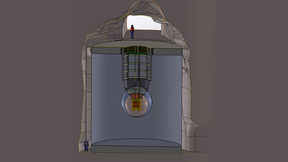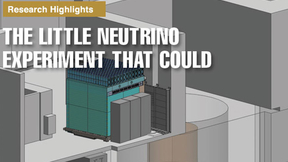Back
While neutrinos are one of the most common particles in the universe, their elusive nature makes it challenging to understand their behavior. In new research from the Precision Reactor Oscillation and Spectrum (PROSPECT) Experiment, scientists have produced final results from measurements of neutrinos emitted by a nuclear reactor at the Oak Ridge National Laboratory. Their…
Lawrence Livermore National Laboratory (LLNL) has received $2.35 million from the Inflation Reduction Act, which aims to support domestic energy production and promote clean energy and to provide the Department of Energy (DOE) national laboratories with resources to keep the U.S. at the forefront of scientific discovery. The funding has been allocated for the Lab-led nEXO…
A tiny, invisible particle could offer help for a big problem — the threat of nuclear proliferation. For more than six decades, scientists have been developing instruments for fundamental physics that can detect antineutrinos, particles that have no electric charge, almost no mass and easily pass through matter. Antineutrinos are emitted in vast quantities by nuclear…
Many experiments conducted by Lawrence Livermore researchers are designed to explore questions of fundamental science. Others are intended to test-drive new mission-critical technologies. Perhaps the most exciting experiments are those that undertake both objectives. PROSPECT, the Precision Oscillation and Spectrum Experiment, is a unique neutrino–antineutrino detection…
Elusive antineutrinos can help monitor nuclear power plants and other activity The United Kingdom is investing nearly £10 million (about $12.7 million) in a joint project with the United States to harness existing particle physics research techniques to remotely monitor nuclear reactors. Expected to be operational in 2024, the Advanced Instrumentation Testbed (AIT) project…
Jason Brodsky says his work is like “looking for a candle in a raging inferno.” But the Lawrence Livermore physicist believes finding that “candle” could be the key to understanding existence itself. Brodsky’s specialty is rare-event detection, both during his Princeton graduate work on dark matter and his current postdoctoral research at LLNL, in which he searches for…
Determining features of the elusive particle known as a neutrino – through the observation of an extremely rare nuclear process called neutrinoless double-beta decay (NDBD) -- could provide a glimpse into the nature of the universe during the earliest moments of the Big Bang. As part of an international collaboration, Lawrence Livermore National Laboratory (LLNL)…
The Precision Reactor Oscillation and Spectrum Experiment (PROSPECT) has completed installation of a novel antineutrino detector that will probe the possible existence of a new form of matter -- sterile neutrinos. PROSPECT, located at the High Flux Isotope Reactor (HFIR) at the Department of Energy’s Oak Ridge National Laboratory (ORNL), has begun taking data to study…
LIVERMORE—Harnessing the unusual characteristics of the elusive subatomic particles known as antineutrinos, Lawrence Livermore National Laboratory (LLNL) will lead a new international multi-laboratory and university collaboration for nonproliferation research. The program will support the development of detection hardware and algorithms to enable improved nonproliferation…













